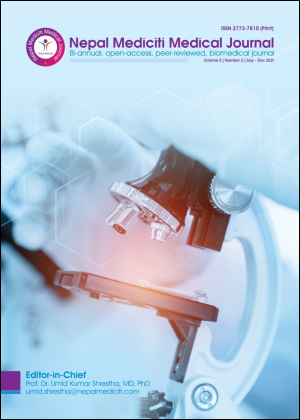Limberg flap as a Primary Treatment for Pilonidal Sinus at Nepal Mediciti Hospital: A Single Unit Experience
DOI:
https://doi.org/10.3126/nmmj.v2i2.41277Keywords:
Limberg flap, Pilonidal Sinus, Primary TreatmentAbstract
INTRODUCTION: Pilonidal Sinus is a common condition with estimated incidence of 260 per million population with more male predilection and is often seen in sacrococcygeal area but has also been described in other areas with hair. The Limberg rhomboid flap was designed by Limberg in 1946 for the closure of a sixty degree rhombus shaped defect with a transposition flap. We would like to share our single unit experience of Rhomboid Limberg flap for Pilonidal sinus in our hospital.
METHODS: This is an ongoing prospective descriptive study in the Department of General Surgery and Digestive Diseases of Nepal Mediciti Hospital from October 2018. The demographic of the patients, presenting symptoms, duration of symptoms and previous interventions are recorded and the Rhomboid Limberg flap surgery is done under regional or general anesthesia in prone position. The patient is given intravenous antibiotic and is instructed to sleep laterally or in prone position for 24 hours. The dressing is removed and the wound is inspected for flap status in the next morning. The patient is discharged on 1st post-operative day on oral antibiotics for 7 days and is followed on 7th post-operative day for removal of suction drain and alternate sutures in the skin and remaining sutures are removed on 10th post-operative day.
RESULTS: We have done 28 cases of Limberg flap for Pilonidal Sinus from October 2018 to December 2020 of which 24 were male patients. None of our patients had flap necrosis. One patient presented with accidental removal of suction drain on 5th postoperative day, however he didn’t develop any wound related complication. One patient had superficial wound dehiscence on 10th post-operative day which healed on its own with dressing. One patient developed seroma from 5th postoperative and was managed with dressing and antibiotics and it healed in 2 weeks. None of our patients have developed recurrence and their wounds have healed satisfactorily with minimal scarring and pain. All the patients were able to resume their regular activities within 21 days. All except 2 patients were satisfied with cosmetic outcome.
CONCLUSION: The Limberg flap is ideal treatment for pilonidal sinus with minimal postoperative pain, short hospital stay, few complications, rapid return to normal activities, good cosmesis, and a low recurrence rate with short learning curve for young surgeons. Hence, Limberg flap should be routinely used as primary treatment for pilonidal sinus.
Downloads
Downloads
Published
How to Cite
Issue
Section
License
Copyright (c) 2021 Nepal Mediciti Medical Journal

This work is licensed under a Creative Commons Attribution 4.0 International License.
This license enables reusers to distribute, remix, adapt, and build upon the material in any medium or format, so long as attribution is given to the creator. The license allows for commercial use.

